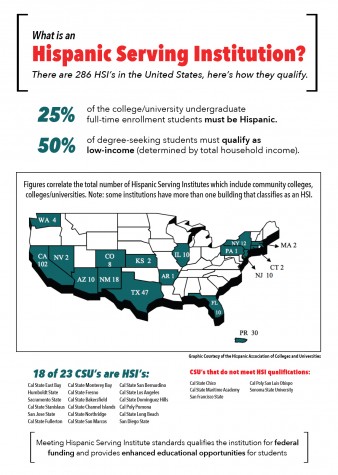CSUEB Hispanic population gets federal help
March 9, 2016
Despite a $2.6 million grant from the U.S. Department of Education for Cal State East Bay earning the distinction as a Hispanic Serving Institution — HSI — in April 2014, it still hasn’t gained much attention.
Most people have no idea what a Hispanic Serving Institution (HSI) is and how beneficial it can be to Latino and Hispanic college students “to boost the success and retention rates of its rapidly growing Hispanic and low-income student population,” according to CSUEB.
In order to become an HSI, an institution must meet two specific requirements. The school must have at least 25 percent of its undergraduate full-time enrollment students be classified as Hispanic and at least 50 percent of “degree-seeking” students at the institution must qualify as low-income. CSUEB met both of these requirements in April 2014 when the Hispanic population reached nearly 30 percent and the low-income population was already over 50 percent. Low-income status is determined by the total number of family members and how much money is made in that household.
Lettie Ramirez is an instructor in CSUEB’s Teacher Education Department and was also one of the grant’s co-authors. The $2.6 million grant will be broken down into $520,000 payments for five years.
“We know how many people graduate, we know how many enter, but we don’t know in between,” Ramirez said. “We don’t know our dropout rate, which is extensively high and it is really scary especially when you look at minorities and STEM.”
Ramirez also said that an HSI distinction is very important for a school to obtain because it allows the institution to seek additional federal funding for programs and services to help Latino and Hispanic students succeed.
According to the University, CSUEB will use the grant to implement things like, “summer academies for rising second-year students, create a sophomore cohort-based learning community, implement new online supplemental resources, develop a student information system, and establish a partnership with the Institute for STEM Education to have academic and social support networks for STEM majors that are discipline specific.”
In 16 U.S. States there are currently 270 HSI classified Universities, with another in Puerto Rico. Eighteen of the 23 CSU universities meet both requirements and are considered HSI. The other 17 CSU HSI’s are: Bakersfield, Channel Islands, Dominguez Hills, Fresno, Fullerton, Humboldt, Long Beach, Los Angeles, Pomona, Monterey Bay, Northridge, Sacramento, San Bernardino, San Diego, San Jose, San Marcos, and Stanislaus.

U.S. Secretary of Education, Arne Duncan, said that grants like these are vital to the success of Latino, Hispanic and low-income students.
“This grant and others like it are aimed to help the rapidly growing number of Hispanic students entering colleges and universities. They give students a greater opportunity for success when it comes to obtaining a degree.
At the 23 CSU campuses there are more than 460,000 undergraduate and graduate students as well as 47,000 faculty and staff members. The grant will allow CSUEB and other institutions that qualify a chance to, “enhance their academic offerings, program quality and institutional stability,” according to CSUEB.
According to a CSU Mentor CSUEB currently has 14,823 students while 42.5 percent are first-year Latino or Hispanic and 28.6 percent are degree seeking.
















